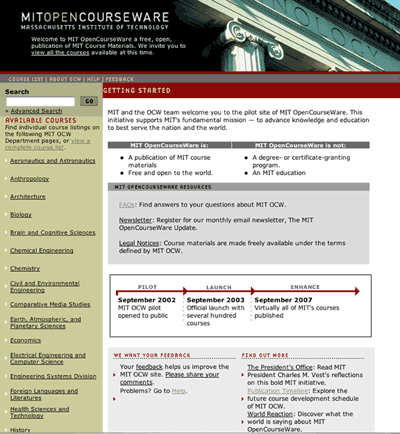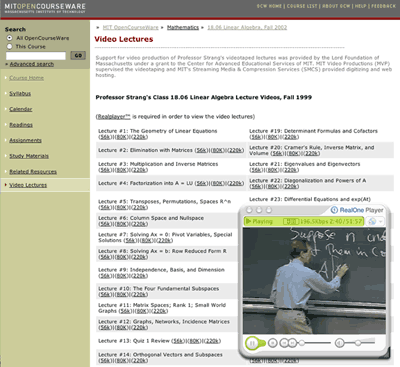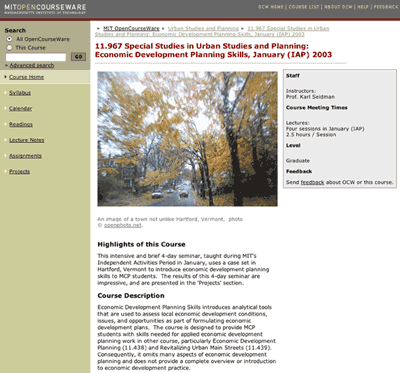OpenCourseWare
The goal of OpenCourseWare (OCW) is to make MIT course materials that are used in the teaching of almost all undergraduate and graduate subjects available on the web, free of charge, to any user anywhere in the world. OCW continues the tradition at MIT, and in American higher education, of open dissemination of educational materials, philosophy, and modes of thought, and will help lead to fundamental changes in the way colleges and universities utilize the Web as a vehicle for education.
The first sampling of course sites opened to the public on September 30, 2002, as a first step in the OCW pilot, which lasts until September 2003, when 500 courses will be published. The public opening included 50 courses (32 published in September with an additional 18 in December 2002), from 23 of MIT's academic disciplines and all 5 MIT Schools—the Schools of Architecture and Urban Planning; Engineering; Science; Humanities, Arts, and Social Sciences; and the Sloan School of Management.
Achievements
The public opening of the OCW pilot site in September was the culmination of 18 months of intense learning, ramp-up, and pilot development. Over the course of the last year, the staff of OCW has been preparing for the launch of 500 courses this September. We made significant strides in five main areas: establishing and executing an efficient, high-quality publication process; building and sustaining a responsive, professional organization; creating an effective technology infrastructure; communicating information about OCW and capturing feedback; and measuring usage and evaluating impact of OCW.
Publication Process
Over the course of the last year, we developed a streamlined and effective process for working with MIT faculty that has helped us prepare for our launch of 500 courses in September 2003. Towards our goals, we have:
- Visited and engaged 32 MIT departments
- Held almost 500 faculty meetings
- Collaborated with Academic Media Production Services (AMPS) and Academic Computing and recommended Stellar to departments as a web publishing option for faculty
- Informed faculty on Intellectual Property (IP) issues and demonstrated OCW IP expertise
- Trained OCW staff on CMS, FileMaker, CVS, Adobe Acrobat, IP, metadata
- Built 370 courses; cleared 234 courses through June 30, 2003; and for IP and copyright concerns, reviewing 9,000 objects
- Developed OCW Richness Index to measure the relative level of completeness of content in each course site
 The OpenCourseWare homepage |
Organization
On June 30, 2002, the OCW team consisted of the executive director, two faculty liaisons, an administrative officer and an administrative assistant. Since then, we have become fully staffed, including a Senior Management Team and a total of 16 full-time staff, and 8.5 department liaisons who have worked with faculty to place their course materials online, both on OCW and for active teaching. In the last year, we have:
- Established a goal-based performance management system
- Through careful financial management, stretched a 27-month budget to 31 months
- Developed a values-based culture, built on the belief that our staff should be:
Technology
OCW's pilot site opened to the public in September 2002 with content from 32 MIT subjects, with an additional 18 subjects added to the site in December 2002. These 50 subjects constituted the OCW Phase I pilot. The work to develop the pilot sites began early in 2002 before OCW existed as a formal MIT department. Work was done by a couple of "on-loan" staff, working with outside contractors and faculty, and management of the work relied on CVS, a source code control system, and lots of colored post-it notes. The primary technical tools were Dreamweaver and Photoshop. This is an environment that our technology director, Cecilia d'Oliveira, refers to as "brute-force HTML" coding. We did what we had to do during the pilot to get the job done and the initial course materials published, but it was clear as we looked forward that the processes and the tools we had used during the pilot phase would not scale.
OCW's goal for September 2003 is to have the course materials from 500 MIT subjects online, a significant increase over the pilot site. In fall 2002 we identified several key requirements that led to our decision to implement a content management system (CMS). We pulled together our high-level requirements and then zeroed in on a small number of vendors, incorporating the input of the consulting firm of Gartner and Forrester. Sapient Corporation, our implementation partner, also provided a lot of guidance, given their experience with CMS implementations. We did not include an open-source platform in our short list given our limited technical staffing within MIT OCW and our belief that the existing open-source platforms did not meet our workflow requirements. In the end we selected the Microsoft CMS 2002 as our target platform. The primary factors in this decision were total project cost, the preexisting MIT-Microsoft relationship, and ease of use.
We completed our initial CMS implementation and began actual production use in April 2003, and we began publishing the OCW web site from the CMS in June. In addition, we have:
- Implemented a production control system and hosted the site on 14,372 Akamai Network servers distributed around the world (reducing user requirements to the "last mile")
- Achieved 99.9 percent up time of the OCW site
- Worked with OKI and the MIT Libraries on interoperability and metadata standards
- Implemented an OCW domain and server infrastructure
 Course 18.06 Linear Algebra features all of Professor Gil Strang's video lectures. |
Communications
One of the biggest challenges we face as an organization is communications. We must focus on sharing the good news of OCW with the MIT community, fostering positive feelings about OCW among the faculty and leadership of the Institute, while at the same time, letting the world know that MIT's course materials are available through OCW and driving people to the site.
We opened the pilot site quietly in September 2002, with little media outreach, but we received coverage in the BBC, Wired Magazine, The Chronicle of Higher Education, and Le Monde, the large French daily newspaper—among others. The quiet opening succeeded in managing expectations of OCW, while also allowing users to find the site through various media outlets. Through June 30, 2003, the OCW web site had received more than 100 million hits. Also, over the course of the last year, we have:
- Delivered more than 100 presentations to various audiences on MIT's campuses, ranging from faculty meetings, to the Graduate Student Council, to alumni audiences
- Spoken about OCW at several educational conferences including EDUCAUSE 2002 in Atlanta, T.H.E. Forum at Louisiana State University, and Syllabus 2003 in San Jose, Calif.
- Launched The MIT OpenCourseWare Update email newsletter, which is approaching a subscriber list of 10,000 engaged OCW users
- Responded to more than 7,000 email messages from OCW users
- Sent communications on a regular basis to MIT stakeholders, deans, and department heads
- Published a series of regular articles in the MIT Faculty Newsletter
- Developed partnership for Spanish and Portuguese language translations of 25 OCW courses by Universia, a consortium of 600 colleges and universities in Latin America, Spain, and Portugal
- Developed a communications plan for the September 2003 launch of 500 OCW courses
 Course 11.967 Special Studies in Urban Studies and Planning, is an intensive four-day seminar taught during MIT's Independent Activities Period in January. It uses a case set in Hartford, VT, to introduce economic development planning skills to students. |
Evaluation
Throughout the course of the last year, we have been developing a complex and comprehensive evaluation plan that will allow us to measure the access, use and impact of the OCW initiative, both here at MIT and in the world. The evaluation strategy calls for a logical flow of evaluation activities over the three phases of OCW.
Over the last 12 months, we measured access to the site, meaning not only the ability for users to get online, but also to encounter a reliable technical infrastructure and have an appropriate level and speed of connectivity. To try to achieve universal access to OCW worldwide has been a tremendous effort and not surprisingly, an iterative one. Evaluation has already played an essential role, leading to such questions as:
Efforts to understand what facilitates or detracts from open access to OCW were critical throughout the Pilot Phase in 2002–2003. Even before the pilot OCW was placed on the MIT web site in September 2002 and in the nine months since then, data have been collected, analyzed and used to identify and resolve access difficulties, utilizing WebTrend data and emails to the OCW Feedback Form. In addition, we received a wide range of anecdotal data from people within and outside MIT via email, telephone, letters, etc.
In order to measure use and impact, as well as access, we have set a firm foundation for our evaluation program in the last 12 months. We have:
- Developed an evaluation portfolio, infrastructure, and plan
- Collected data on the cost of level of effort (LOE) by process step/type of course
- Developed a draft sustainability plan for OCW going forward
Finances and Funding
The pilot phase of OCW, which began July 1, 2001, runs through September 30, 2002. Funding for this pilot phase, finding came from the William and Flora Hewlett Foundation ($5.5 million), the Andrew W. Mellon Foundation ($5.5 million), and MIT. A proposal for Phase II funding was due to the foundations in October 2003.
Personnel
Appointments as of June 30, 2003 are executive director Anne H. Margulies; technology director Cecilia d'Oliveira; administrative officer Pam Homsy; production and publication manager Laura Koller; communications manager Jon Paul Potts (formerly of the Alumni Association); seven faculty liaisons (Stephen Carson, Tamara Cupples, Abe Dane, John Dennett, Elizabeth DeRienzo, Farnaz Haghseta, and Sandra Mallalieu); two IP coordinators (Lindsey Weeramuni and Geoffrey Wilson); our core production team members (Kevin Nichols and Garth Shaneyfelt); and office administrator Kathleen Mitchell.
More information about OpenCourseWare can be found on the web at http://ocw.mit.edu/.